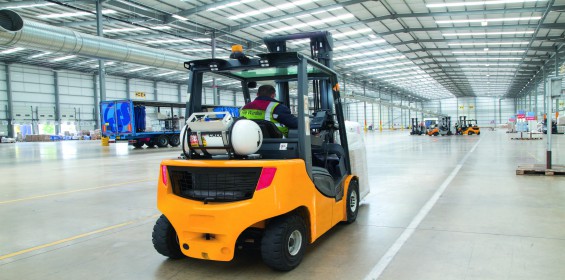Busting the most popular forklift truck fuel myths
Published: 15 October, 2019
Andy Kellett, FLT Specialist at Calor, discusses some of the most popular myths surrounding fuels for forklift trucks (FLTs).
Myth #1: Electric is the most environmentally-friendly fuel
As the take-up of BioLPG – a renewable fuel – continues, the assumption that electric is the greenest fuel available for FLTs is being challenged more and more. BioLPG is created from ethically sourced feedstocks, and organisations even receive a certificate from the Green Gas Certification Scheme to demonstrate how clean the fuel is, which can then be used as part of a business’ sustainability credentials.
The fact that BioLPG is chemically identical to LPG is another big draw for fleet managers, as there is no requirement to invest in new equipment or infrastructure. BioLPG is simply a drop-in fuel for those already using LPG. For fleet managers with sustainability goals – which is becoming an increasingly key concern, as big brands across the supply chain choose and champion other businesses that are as equally eco-conscious as them – BioLPG is a quick and hassle-free way to help meet these green ambitions.
The exact reduction in CO2 emissions from BioLPG depends on the blend of the fuel with LPG. It offers minimum carbon savings of at least 20%, and potentially up to 32%. This is based on a blend of 40% BioLPG and 60% conventional LPG. The potential carbon savings are even greater if a higher BioLPG blend is used.
It’s also important to remember that while electric is often considered a ‘clean’ option for FLTs, this electricity will be mainly taken from the National Grid, with fossil fuels such as coal a part of this mix. A lot of this energy is not generated in a particularly efficient way, with much of the energy in coal and nuclear used to produce electricity simply lost as waste heat. Therefore, it quickly becomes apparent that electric is not as environmentally-friendly a fuel as many first believe.
Myth #2: Diesel is the tried-and-tested ‘safe choice’
Diesel has long been the ‘go-to’ fuel for FLTs. Historically, a diesel engine truck has been superior to electric models, owing to its lifting capabilities. They were also perceived historically as able to operate well on gradients, and generally offer reasonable maintenance and servicing costs.
However, emissions and air quality are big areas where diesel struggles, and this is fast becoming the main reason why fleet managers are deciding to source alternative fuels. While exhaust fumes and diesel particulates may be able to easily escape to the atmosphere when used outside, the pressure for greener, more environmentally-friendly FLT fuels is accelerating.
Let’s use an example to demonstrate just how dramatic a difference the switch from diesel to LPG can make to a fleet’s emission levels. For a fleet of 20 diesel FLTs in operation for 14 hours a day, six days a week, these would produce annual CO2 emissions totalling 524 tonnes. Should they switch to BioLPG, however, these emissions fall to just under 300 tonnes, representing a reduction of over 200 tonnes, or 43%. These reductions could be integral to organisations under pressure to focus on more sustainable business practices.
While exhaust catalysts and purifiers can reduce noxious emissions, these still only make the machines acceptable for occasional indoor use. In contrast, LPG emits 98 per cent less particulate matter than diesel, and these emissions are lead- and soot-free. This means LPG-fuelled FLTs can be used in sensitive production environments, such as food and pharmaceutical manufacturing facilities. When also fitted with a three-way catalyst, hydrocarbon and carbon monoxide emissions drop to virtually zero.
As such, diesel is no longer seen as the ‘go-to’ fuel and is quickly falling out of fashion due to its impact on air quality. This is especially true for fleet managers that are investing in new FLTs or those with a lease renewal coming up.
Myth #3: The introduction of EU Stage V emission standards means electric is the only option
Since the beginning of January 2019, diesel and LPG FLTs needs to comply with the EU Stage V standards for non-road mobile machinery.
For LPG FLTs, emissions of particulate matter are not a problem under the new standards. However, nitrous oxides will need to be eliminated via a three-way catalytic converter. The good news is that these are inexpensive, require minimal maintenance and do not have to undergo the lengthy regeneration processes associated with diesel particulate filters (DPF).
In contrast, many diesel engines will be affected in a big way. With the introduction of these new standards, more advanced DPF cleaning systems and operating regimes will be required to comply. For less sophisticated diesel engines, this will result in longer periods of downtime and greater expense.
One approach the industry has taken to overcome this issue is by lowering the combustion temperature using cooled exhaust gas, which dilutes the amount of oxygen in the combustion chamber. Yet this results in increased soot, meaning the engine requires a DPF to prevent the soot from being emitted.
This DPF, however, needs to be recharged at regular intervals, which is a lengthy process that has to be performed once or twice a week. This requires an FLT to be taken out of service and the engine to be revved at full engine RPM for between 20 minutes to half an hour, in order to burn the soot that has collected in the particulate filter. Large amounts of fuel are used during this process, and then there is the downtime and inconvenience of the time-consuming and repetitive process – not to mention the associated costs with burning the extra fuel as part of this.
So, is electric the way to go? Not necessarily. While electric FLTs are beginning to edge out from solely being used in warehouses and into rugged heavy-duty equipment too, the adoption of electric as a mass-market solution for these heavy-duty applications is still a long way off. Furthermore, the high initial purchase price is a big barrier for many organisations.
With LPG models able to cope easily with the recently-introduced EU Stage V standards via an inexpensive three-way catalytic converter, LPG is a solution that is available now – and long into the future – for FLT fleets. Many diesel models will struggle with the EU Stage V standards that have come into force, but LPG’s reliability and cost-effectiveness when compared with electric models will ensure it remains a popular choice for fleet managers.
For further information please visit: www.calor.co.uk/flt






 PYROBAN reports that the emissions regulations (EU 97/68/EC Directive) have been amended to support the special application of diesel engines, such as those in forklifts, used in potentially explosive atmospheres, where safety is paramount.
PYROBAN reports that the emissions regulations (EU 97/68/EC Directive) have been amended to support the special application of diesel engines, such as those in forklifts, used in potentially explosive atmospheres, where safety is paramount.
